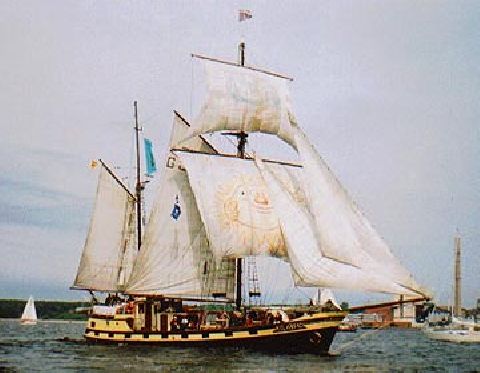25 Foot Waves Made The Passage Exciting
On the road…again!
Afghanistan to Zambia
Chronicles of a Footloose Forester
By Dick Pellek
Santo Antão, Cape Verde
There were so many adventures packed into the memory of Santo Antão that Footloose Forester sometimes forgets that he was a paid employee on various work assignments there. Perhaps the most haunting memory was the first trip to the western tip of that windswept island in the Barla Venta island group of the Cape Verde Archipelago. The passage was by sailing ship from the Port of Mindelo on the adjacent island of São Vicente. There were no roads to our destination, so it was either overland by mule from the tiny city of Porto Nova, or directly to our destination by private boat. We chartered a boat. It was a sloop, a smaller version of the Ernestina, a famous wooden schooner that was once a whaling vessel in the Cape Verde fleet some 50 years earlier. The new owner, a Dutchman, bought the sloop after he himself helped restore the Ernestina, so that he could sail with his family on both sides of the Atlantic. He had since installed a diesel engine as a safety feature, in case the winds were undependable, but otherwise, he preferred to use the sails.
Four USAID project employees made the trip. It was the Project Manager who booked the private passage and although he was criticized for seeming to make it into a junket, he was right to do so. It was either a few hours passage from Mindelo, or about two days by mule from Porto Nova. Footloose Forester should know—on his second trip he did travel by mule and by foot to the same destination at Tarrafal.
Everyone who made the return trip by sailboat from the placid little bay at Tarrafal will never forget it. Nearly everyone got seasick (including 3-4 Cape Verdean fishermen who were hitching a ride back to Mindelo) but since they all stayed below decks in a tiny hold, the Footloose Forester never had to smell the stink or slosh around in the puke. He chose to stay on deck and marvel at the 25-foot waves that tossed us around like a cork. It was a vivid spiritual experience and although he might have seemed foolish to others for staying on deck in the lashing rain, he did not want to miss a moment of the tempest that swept the 40-foot boat into a maelstrom just 20 minutes after we set sail. The captain knew there was a squall coming, but he later admitted that he thought he could get beyond the treacherous channel where the winds were most severe before the storm arrived. He also admitted that he was concerned for the safety of his passengers. A few of the fishermen thought they were going to die.

The Ernestina, a former whaling ship that still plies the seas. The captain of our sloop helped to restore it in Bedford, Massachusetts several years earlier
The following year the Footloose Forester returned alone to Santo Antão to monitor the progress of our dike construction project. This time, it was definitely going to be overland by mule. He was looking forward to another adventure; he was not disappointed. The ascent up the face of the steep mountain at the outset of the mule trip was the most remarkable proposition that he ever remembers. There were a few switchbacks that one could see when standing at the trailhead, but Footloose Forester would have never thought that animals could negotiate that trail, and on a regular basis. But he usually gave others the benefit of the doubt, so it was not long before he found himself looking back into the valley from a trail so narrow that in some places you could touch the rock face with your left hand and spit into space on your right side. What a truly haunting memory! A few places were so narrow, and so steep, that the mule skinner guide asked him to dismount, to be on the safe side. Footloose was more than happy to oblige. As he now remembers, a few of the drop-offs were hundreds of feet down, with rocky outcrops along the way.
Further along the way, on a long section of ridgeback, he was thrown headlong over the mule’s ears and landed amid a couple of boulders. Between them, but not on them. On the way back, he was again thrown off the same mule and at the same place, when the cinch strap broke and the saddle came off. He was thrown backward this time, but again avoided the sharp stones. By way of analysis, the reason why getting thrown at the same place was because the spot was a contact zone between a steep pitch and the first stretch of level land. The animal lurched forward onto the flat in one direction; and lurched forward to gain a foothold on the slope, in the other direction. But when you’re lucky, you’re lucky. No broken bones or lasting pain. At least that spot was not the scariest sector of that long trail.




